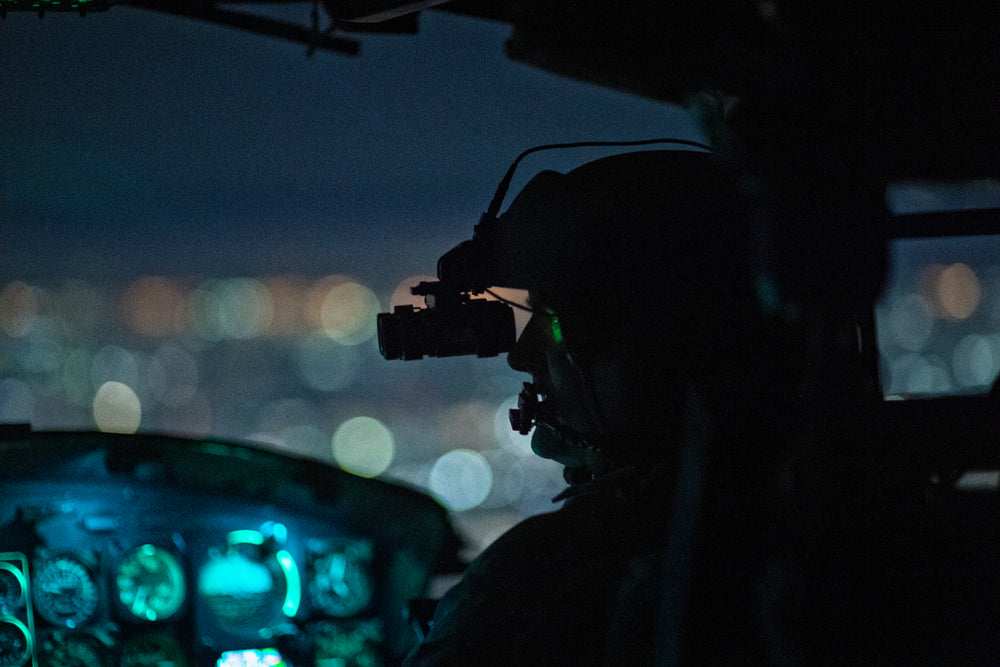What is EBI?
"This is the amount of light you see through a night vision device when an image tube is turned on but no light is on the photocathode”.
- What does that mean?
The impact of Equivalent Background Illumination (EBI) is a bit more dynamic than this definition might suggest. If you aren't aware of what a photocathode is, it's also a difficult explanation to understand (an illustration of an intensifier tube with photocathode is included further down in this article). Lastly, EBI's impact on total system performance is pretty misunderstood.
As of this writing, "Milspec" EBI has a limit of 2.5 max with a lower number preferred (EBI of 0.0 is possible). This range helps demonstrate a tube's ability to resolve an object in the darkest light possible.
EBI is affected by temperature, and a warmer environment will increase EBI. As a result, the temperature of the operating environment can be one factor for considering the importance to assign to EBI when evaluating specs of a given tube.
Visually speaking, High EBI typically makes the background of an image brighter - it's a bit reminiscent of the light pollution above a suburban or urban area in a night sky vs. a black sky in a rural area.
The diminished contrast between black and white caused by higher background illumination is also why astronomers seek tubes with lower EBI numbers. They're usually seeking an image of a white star, galaxy, etc. against a darker background.
PVS-14s with low EBI and high SNR are particularly well suited for astronomers in combination with a telescope.
On the other hand, a user wearing helmet mounted night vision generally isn't impacted by EBI to the same degree. Even at 2.5 EBI (and even slightly higher), it usually doesn't change the clarity of ones surroundings in the majority of light environments. But your use case does matter.
EBI's impact may be overstated in some online communities and forums.
EBI and SNR are similar from the perspective that they both affect visual clarity and "noise" but EBI is particularly impactful in one environment - near total darkness. In very low light, poor SNR (low signal strength and high noise) typically produces a lot of scintillation ("tv static"). Very high EBI may produce additional noise as well and can also resemble a haze.
One may assume that a device with very low EBI will perform a certain magnitude better than one with a higher EBI. In our view, considering specs in this way is flawed. Keep in mind that night vision technology is constantly improving - what may have been written about tubes and common specs just several years ago might no longer be the case.
SNR, EBI, gain, and every other spec you'll find on a data sheet tell a story about a tube and they all impact tube performance together in a holistic way. However, it's become somewhat common for commercial end-users to evaluate specs using on a "checklist mentality".
For example, some might set their EBI limit at 1.0 because they've read or heard that sub 1.0 EBI is ideal. Evaluating EBI on a standalone basis (or any spec, for that matter) is problematic for a few reasons.
First, what's ideal for one end-user (using the astronomy example) isn't necessarily applicable to another.
Second, placing hard limits around certain specs ignores the notion that all specs together in their totality tell a story about a tube's performance.
What's wrong with only seeking a tube below 1.0 EBI?
Only seeking a tube with less than 1.0 EBI may work against you because it assumes SNR, gain and all other specs are a constant amongst tubes. If SNR were always about 30 and under, an EBI of less than 1.0 might be an appropriate target. However, it's certainly not a requirement for a great looking tube. It's our view that SNR typically overshadows EBI in terms of its impact on total tube performance.
Having hard limits around certain specs can hurt overall performance if you ignore the specs of a tube in their totality.
Higher SNR values are correlated with higher EBI.
If you sorted through a large batch of tubes, and searched for the lowest EBI numbers (lets hypothetically say 0.2 on average), many would also carry lower Signal to Noise ratios.
Why is that?
Generally, it's because these tubes are likely have a lower EBI due to lower photocathode sensitivity which may also result in lower signal to noise ratios.

Source: Photonis
Why does EBI occur?
Equivalent background illumination is caused by thermionic emission by the photocathode. Essentially, the photocathode is converting photons to electrons (light to energy particles) but some extra electrons are created due to heat. In turn this creates extra glow, and may also cause image noise. Usually, (though not always) a more powerful photocathode produces greater EBI.
Higher photocathode sensitivity correlated with higher SNR. This is why it's common for tubes with the highest SNR values to also have high photocathode sensitivities as well as higher EBI values (~1.3 or higher in unfilmed tubes based on our experience).
To simplify, high-spec night vision devices have powerful engines that put out more heat and light which causes some extra glow and noise in the form of EBI.
SNR and Photocathode Sensitivity are certainly correlated but correlation is not causation and it doesn't always occur. This emphasizes why it's important to avoid falling into the trap of looking for certain specs in isolation of each other.
There can be differences between Elbit Thin-Filmed tubes and L3Harris unfilmed tubes with respect to typical spec ranges, but EBI numbers commonly start to rise above 1.0 at ~34+ SNR. At that level, and as SNR goes even higher, an EBI below 1.0 starts to become less realistic.
What's the bottom line?
The variables that result in power and clarity across many light environments, may, as a side effect, increase EBI. At the same time, tubes with excellent SNR usually offset the effects of higher EBI.
All other specs being equal, low EBI may result in better clarity and contrast in the very darkest environments.
It's our opinion that prospective night vision buyers of helmet-mounted NODs should prioritize SNR while considering the balance of other specs. EBI is important, but as long as SNR is excellent (~32+ as of this writing), an EBI figure under ~1.7 (still well below the Milspec limit as of this writing) is going to look and perform great for most users.
Today’s most powerful tubes are illuminating extremely dark environments and clarity gains from low EBI to a helmet mounted user are diminished in favor of a higher SNR.
For most users it doesn't make sense to sacrifice higher SNR for lower EBI. That said, everything is a balance.
If you have any questions about EBI or other considerations for choosing a night vision device, please feel free to reach out to us - we're happy to help.





Leave a comment